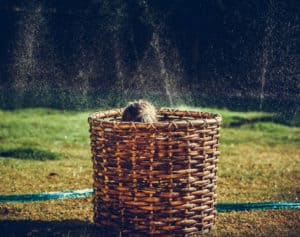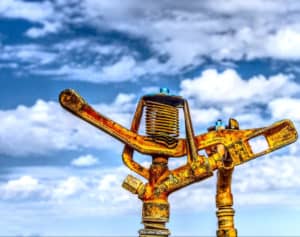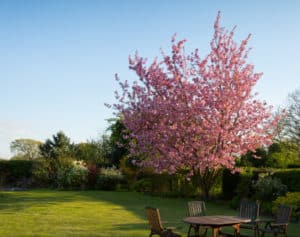Sprinkler systems can seem a bit intimidating to most people. How does the water system even work? What if it gets clogged? Which materials should I go with (especially in Southern Wyoming’s windy climate)? We hear quite a few of those questions, so we’ve written this article on sprinkler system basics to help you understand yours – especially if you’re installing one for the first time or even re-doing it.
What Is A Sprinkler System For?

You guessed it – to keep your landscaping green and beautiful during sunny Wyoming summers. Though the idea is the same across the board, there are several different ways of going about keeping your lawn and gardens happy. The first one is probably what comes to mind right off the bat when we say the word ‘watering’: the sprinklers that spray water over your lawn (and potentially the neighborhood children as well). Most of these are designed to cover large areas and water relatively shallowly, which is why they’re perfect for lawns.
The second system that’s often used in Wyoming is soaker hoses. These are used to conveniently and easily water flower beds, especially those that are full of low-growing plants. Soaker horses look just like your run-of-the-mill garden hose except that they’re usually darker in color to help them blend in. They have small holes in the lining that allow water to trickle out into your garden.
Your third option is to use a drip system, which is particularly effective for vegetables and high-growth plants. Drip systems are similar in design to soaker hoses, but instead of sitting on the ground, they’re put up higher in order to let the water drip down. At this point, you may be thinking: what difference does placement really make? With a drip system, you can place the water stream exactly where it will do the most good for those tall, lanky plants, thus saving water. It also reduces the likelihood of vegetation-killing mold.
If you’ve got lots of trees or other large plants in your yard, another thing to consider is using a bubbler system. Bubblers are great for trees because they’re designed to soak the ground, which gets water into deep root systems that a regular sprinkler system likely wouldn’t even touch.
How Does It Work?

There are two basic kinds of irrigation systems: metered, and pump. Metered systems come from an established water line, normally your city’s. This is the most accessible option for most people, but you will have to pay for the water that you use. Usually, this system is tied to your home’s existing water line so that you can pay for all your costs in one go, which helps with convenience. On the other hand, pump systems are drawn out of an existing water source, such as a lake, pond, or river. In most cases, there’s no cost associated with this system! However, it’s not always a viable option for larger cities like Laramie and Cheyenne simply because local rivers and lakes of able size aren’t usually convenient to residential areas.
There are several important components of your system that you’ll need to know about in order to successfully plan and run it.
The Controller: This is just what it sounds like: the interface that controls the whole thing. This can allow you to control where and when your system will turn on. You can even set it to go on a timer so it’ll run on a schedule when you go out of town, or even in your day-to-day life, without you having to worry about it.
Zones: Due to water pressure concerns, you can’t run your entire sprinkler system at once. Instead, it’s usually divided up into sections called ‘zones’. These divisions will depend on what kinds of landscaping you have where and also what shape your lawn is. Mostly, you will want to look at your yard and analyze what the most efficient way is to water all of the areas that need it. It may help to have a professional guide you through this process.
Heads: These are the actual mechanisms that irrigate your lawn. There are different types of heads, and all are designed to cover different areas effectively while saving you on water costs. Ultimately, the shape of the zone being watered will be the deciding factor in what head is used.
Shutoff Valve: Just like with any system, if something goes wrong, it’s important to have a way to turn it off safely. Irrigation systems are the same way. Shutoff valves provide a place you can go to safely turn it off.
There are several other components of your sprinkler system that are below ground. Your main line is the pipe that carries water to the entire area, so if it is damaged, it will affect the entire thing. Individual zone lines, however, carry water to only a specific zone. If something goes wrong with one of those, it only affects that one area of your lawn.
Why Should I Get One?

There are several great reasons to invest in a sprinkler system! Here are a few to start off with:
- Long-Term Savings. Irrigation systems can be expensive at first glance, but they provide the benefit of using only as much water as is necessary to get the job done. In the end, they will pay for themselves in the savings gained over hand-watering.
- Convenience. Imagine going on vacation without having to hire a lawn-sitter. Imagine not having to move a sprinkler every twenty to thirty minutes, or spend time watering your garden. Imagine how much easier it will be to weed your flowerbeds after your soaker hoses have done their job and softened the ground up!
- Increase Home Value. Having a functioning sprinkler system can increase your home’s value, especially if you’ve used it to create a gorgeous lawn.
While an irrigation system is something a dedicated do-it-yourselfer could install, we recommend getting help from a professional to make sure you maximize efficiency and minimize costs. If you’re thinking about taking this step, give us a call! We’d love to help you create the lawn of your dreams.